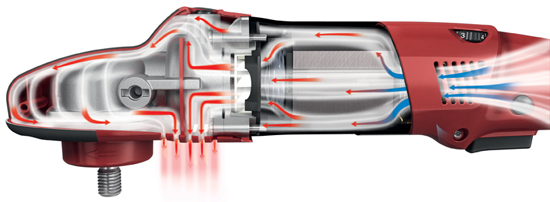Very nice review Mike. That Flex sure does have plenty of good things going for it. The only real negative seems to be the high initial cost.
Quality never costs money it makes money...
The one remaining unanswered question I have is, can it be used for high volume paint correction work? The DeWalt looks heavy duty, like it was made for high volume work. Can the same be said of the Flex?
According to Flex the answer is yes. They state that up to an 8" diameter pad can be used with the Flex PE14 but I prefer to stay a little smaller especially for wool pads.
More reciprocating mass creates more torque
My personal thoughts are that if you're going to be buffing out sanding marks all day long or removing oxidation from large boats all day long
then a full size rotary buffer would be a better choice.
The
gears are bigger in size as are the rest of the components in a full size rotary buffer and
I think having more reciprocating mass creates more torque and this is something you would want if you're going to be doing heavy compounding and polishing with full size pads, (8" and larger), 6 days a week.
It does look beautiful indeed. No way i could swing that kinda cash for a rotary right now but its nice to have some input as to a comparison of the 2 polishers.
Quick question...what major differences do you see between the PE and the 3403 flex rotary?
First major difference is the new Flex PE14 has the design that flushes the tool with air to help the tool run cooler.
More information and a video on this page,
The New FLEX PE14-2-150 Rotary Buffer
Also to those who were interested in the 3" pads...AG does sell some...they are made by Griots...of course!
Correct and these work well too. You can see them in action here,
Pictures + Video of 1932 Ford Highboy Extreme Makeover
The 3" pads I'm using are some prototypes...
I must say that detailing cart looks super sweet....another wish list item...grrr....i wont buy it till i finally have a stationary place to do my detailing...too bulky for mobile detailing..im 25..i can still lean over to clean my pads LOL.
The cart is nice, it makes using the pad washer a lot easier plus gives you plenty of storage space for other related tools.
After about 6 hours of running both rotary buffers here's what I think, the new DeWALT is a great rotary buffer especially for the price. The 600 RPM low range is the most valuable feature. I also really like the rubber bumpers on the back side that enable you to set it down on a polished fender or hood without scratching the paint.
Apples to Oranges
Comparing the Flex PE14 to any of the full size DeWALT rotary buffers, or the Makita, or any other brand of full size rotary buffers is like comparing apples to oranges in that the Flex PE14 is a true compact rotary buffer and falls into the
Compact Size category, while the DeWALT DWP849X falls into the
Full Size category for rotary buffers.
Makita 9227C vs DeWALT DWP849X
A better comparison would be to compare the Makita 9227C with the DeWALT DWP849X as they are much more similar and my guess is that DeWALT introduced this new model to compete against the Makita rotary buffer. Both of these buffers, the Makita or the DeWALT would be great choices. I've always been a fan of Makita rotary buffers if for no other reason because I used one for years until it finally wore out having purchased it new in 1988.
The best of both worlds
In a perfect world a person would have at least
two rotary buffers, a
full size working dog for doing all of the
grunt work and a
compact, light-weight rotary buffer for when you need to do
surgical precision work. This way you can use the one that best fits the job at hand.
The compact size and low weight of the Flex PE14 plus the 600 RPM range are the features I'm most attracted to. It's
light weight and
small size make it really easy to control when doing intricate work. Perhaps we'll see the introduction of other compact, lightweight rotary buffers into the future.
After the compounding the upper half of the 1949 Sedan Delivery, I just switched over to the Flex PE14 due to the light weight and compact size features. I could have used either for the rest of the job by my preference was for the easiest tool to work with as this streetrod has a lot of real-estate to buff.
Here's some pictures to show relative sizes...
The two Flex rotary buffers on the left are in the
Compact category while the other 4 rotary buffers are in the Full Size category. Comparing the compacts with the full size rotary buffers can be done but it trends towards the comparing applies to oranges analogy as in person and in use you can tell right away when you switch from a full size to a compact or visa-versa.
The new DeWALT DWP849X is wider and more bulky like the other full size rotary buffers in these pictures.
You can that the Flex is more narrow from top to bottom...
:buffing:




































